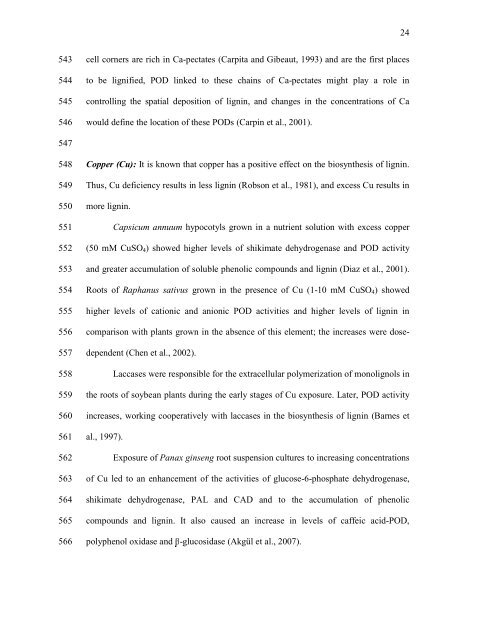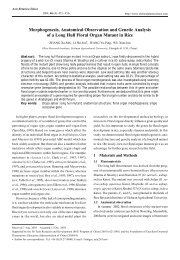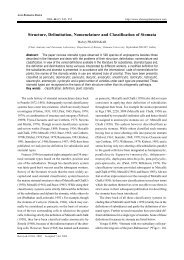Abiotic and biotic stresses and changes in the lignin ... - ResearchGate
Abiotic and biotic stresses and changes in the lignin ... - ResearchGate
Abiotic and biotic stresses and changes in the lignin ... - ResearchGate
Create successful ePaper yourself
Turn your PDF publications into a flip-book with our unique Google optimized e-Paper software.
24<br />
543<br />
544<br />
545<br />
546<br />
cell corners are rich <strong>in</strong> Ca-pectates (Carpita <strong>and</strong> Gibeaut, 1993) <strong>and</strong> are <strong>the</strong> first places<br />
to be lignified, POD l<strong>in</strong>ked to <strong>the</strong>se cha<strong>in</strong>s of Ca-pectates might play a role <strong>in</strong><br />
controll<strong>in</strong>g <strong>the</strong> spatial deposition of lign<strong>in</strong>, <strong>and</strong> <strong>changes</strong> <strong>in</strong> <strong>the</strong> concentrations of Ca<br />
would def<strong>in</strong>e <strong>the</strong> location of <strong>the</strong>se PODs (Carp<strong>in</strong> et al., 2001).<br />
547<br />
548<br />
549<br />
550<br />
551<br />
552<br />
553<br />
554<br />
555<br />
556<br />
557<br />
558<br />
559<br />
560<br />
561<br />
562<br />
563<br />
564<br />
565<br />
566<br />
Copper (Cu): It is known that copper has a positive effect on <strong>the</strong> biosyn<strong>the</strong>sis of lign<strong>in</strong>.<br />
Thus, Cu deficiency results <strong>in</strong> less lign<strong>in</strong> (Robson et al., 1981), <strong>and</strong> excess Cu results <strong>in</strong><br />
more lign<strong>in</strong>.<br />
Capsicum annuum hypocotyls grown <strong>in</strong> a nutrient solution with excess copper<br />
(50 mM CuSO 4 ) showed higher levels of shikimate dehydrogenase <strong>and</strong> POD activity<br />
<strong>and</strong> greater accumulation of soluble phenolic compounds <strong>and</strong> lign<strong>in</strong> (Diaz et al., 2001).<br />
Roots of Raphanus sativus grown <strong>in</strong> <strong>the</strong> presence of Cu (1-10 mM CuSO 4 ) showed<br />
higher levels of cationic <strong>and</strong> anionic POD activities <strong>and</strong> higher levels of lign<strong>in</strong> <strong>in</strong><br />
comparison with plants grown <strong>in</strong> <strong>the</strong> absence of this element; <strong>the</strong> <strong>in</strong>creases were dosedependent<br />
(Chen et al., 2002).<br />
Laccases were responsible for <strong>the</strong> extracellular polymerization of monolignols <strong>in</strong><br />
<strong>the</strong> roots of soybean plants dur<strong>in</strong>g <strong>the</strong> early stages of Cu exposure. Later, POD activity<br />
<strong>in</strong>creases, work<strong>in</strong>g cooperatively with laccases <strong>in</strong> <strong>the</strong> biosyn<strong>the</strong>sis of lign<strong>in</strong> (Barnes et<br />
al., 1997).<br />
Exposure of Panax g<strong>in</strong>seng root suspension cultures to <strong>in</strong>creas<strong>in</strong>g concentrations<br />
of Cu led to an enhancement of <strong>the</strong> activities of glucose-6-phosphate dehydrogenase,<br />
shikimate dehydrogenase, PAL <strong>and</strong> CAD <strong>and</strong> to <strong>the</strong> accumulation of phenolic<br />
compounds <strong>and</strong> lign<strong>in</strong>. It also caused an <strong>in</strong>crease <strong>in</strong> levels of caffeic acid-POD,<br />
polyphenol oxidase <strong>and</strong> β-glucosidase (Akgül et al., 2007).







